Poland – Silesia, Lower Silesia, Opole (Katowice, Wrocław, Częstochowa) August 20-21, 2019
KATOWICE and SILESIAN METROPOLIS (pop 295,000)
The Katowice urban zone has about 2.7 million people.
History. In 1742, it came under the control of Prussia and many German craftsmen settled including the first Jews. It was not a medieval town and the center only formed in the mid 19th century. Industrialization was mainly steelworks. Following the Silesian Uprisings of 1919-21, it was annexed by the Polish Republic and many Germans emigrated back to Germany.
Silesian Insurgents Monument. This is a monument to those who took part in the three Silesian Uprisings of 1919, 1920 and 1921, which aimed to make the region of Upper Silesia part of the newly independent Polish state. The monument was unveiled on 1 September 1967. The wings symbolize the three uprisings, and the names of places where battles were fought are etched on the vertical slopes. The monument was funded by the people of Warsaw for Upper Silesia.
This huge monument of three huge abstract bronze “wings’ sit in the center of large cobble “plaza”. Each has a date – 1919, 1920 and 1921. They surround a small bronze metal disc with many cities that were the battlefields in the Silesian Uprising of 1919-21 written on the perimeter: Lenino, Studziani, Mielnik, Lipiny, Grunwald, Pisie Ple, Sora SW. Anny, Wodzislaw, Westerplatte, Berlin, Narwik, Cedynia, Wal Pomorski, Kedzierzyn, Arnheim, Kolobrzeg, Monte Cassino, Budziszyn, Lasy Janowski, Hel Falaise, Warszawa. A small elevated stone says Katyn 1940-2010. 
Spodek. In the NM “Bizzarium” series, this large round building with a flying saucer roofline (Spodec translates as the “saucer”), is a performance venue with two tiers of seats surrounding an oval area with a glass dome in the center. Huge gantries of lights and speakers are mounted on the roof and a central cylinder hangs from the center of the skylight. Chairs were set up on the floor. Music concerts, ice hockey and volleyball are played here. Very nice.
A new philharmonic hall and a hotel with a restaurant are nearby.
CHORZOW (pop 107,000)
Part of the Upper Silesian Metropolitan Union, it was formed in 1934-39 by amalgamating 4 adjacent cities. Historically it dates to the 12th century. It grew after the Royal Iron Works was established in 1797 around the coal deposits. From 1942-45, it held 2 branches of the Auschwitz concentration camp.
SASKSI PARK Covering 30% of the city’s area, it has large areas of grass and mature trees, most of it treated as botanical gardens with labels in Polish for many trees. It has several restaurants, pubs, festival grounds, a swimming pool, tennis complex, ethnographic park, zoo and sports stadium.
Rosarium. A special part of the greater botanical garden with 7 hectares of rose gardens and 385 varieties, not much in bloom at this time of the year.
Silesian Planetarium. Unfortunately the only shows were Polish.
Zabrze Botanical Garden. This municipal garden has nice flowers, shrubs and trees. Free
GLIWICE
Established in the 13th century, the town was successively under the control of the Czech, Austrians and Germans (1740-1945). Most industry is agricultural plus an iron mill. It was the eastern most city of Germany.
Museum in Gliwice. Archaeology with pots, axes, half a mastodon skeleton and half a hairy rhinoceros skeleton. The usual ethnographic exhibits including traditional costumes and trade guilds. A highlight is the elaborately painted, carved wood sarcophagus of Henry IV. Discusses the many wars including the three Silesian Uprisings of 1919-21. Free
Piast Castle. A small manor house with a round tower, it holds the museum.
Gliwice Radio Station. The station and tower were built in the 1930s and is most identified with the Gliwice provocation (why the Nazis wanted control of the Gliwice area). Many original radio devices and equipment are housed here. The tower is the highest wood structure in the world at 111m. The larch wood tower is connected with 16,000 brass bolts and illuminated with 8 large reflectors visible for many kilometers. It sits in the middle of a large grass park. 
Tarnowskie Gory Lead-Silver-Zinc Mine and its Underground Water Management System.
Galena (the natural form of lead sulphide and an important source of silver – lead content is about 86% and silver .2-1%) was discovered here by a farmer in 1490. From 1526 miners constructed 20,000 shafts each with its own name and registration. Mining was with pickaxes, hammers and spades.
Water in the mine was a big problem and had to be pumped out. Initially water was taken out in buckets and special leather sacks. Then horse treadmills were used. The first steam engine came from England in 1787 and 7 more were made in the area. Drifts and adits were constructed with a slope so that water flowed away outside the mine. St Jacob adit was constructed in 1563. The Black Trout adit is the boat float taken at the end of the tour.
2 million tons of are was mined in the Frederic mine until 1913.
The tour starts in the museum with views of Tanrnwskie Gory, walker devices to transport buckets filled with ore to the surface, dynamite using straw for fuses, lamps (initially tallow then carbide), a model steam engine, horse treadmills (in the 16-17th centuries, about 600 horses worked in the mines), ore crushers using water wheels, washers to remove sand and clay from the crushed ore (these were 14 miles from the mine so that the water didn’t contaminate the mine water that was used in the town), smelting (ore was mixed with charcoal – lead melts at 321° C and silver at 963° C).
The walking part of the tour is about 1740m. Everyone wears a hard hat, very necessary with the many low tunnels traversed in the tour. Descend 40.m down the Angel shaft in an elevator. View old extraction galleries. About 60% of mining was waster material that were used to fill post-mining voids that helped to support the roof. As more pockets of galena were found, second chambers were created and the excavations became bigger and bigger. There were 70 miners in 1784, but this rapidly grew to 660. The roof was supported with single wooden props and then box cribs made of dolomite, railway rails and concrete. The final part of the tour involves taking narrow boats along a 270m long tunnel. There is a plaque commemorating the 1834 meeting of two tunnels moving from opposite sides. 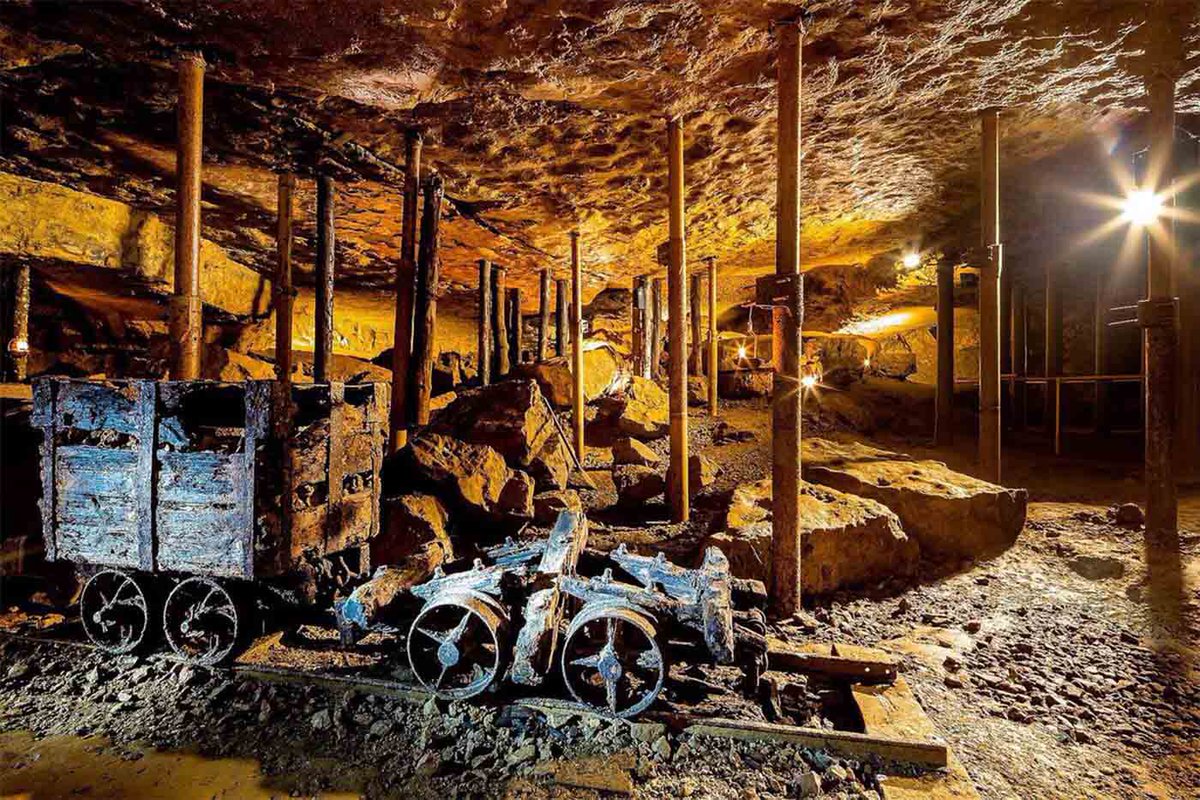
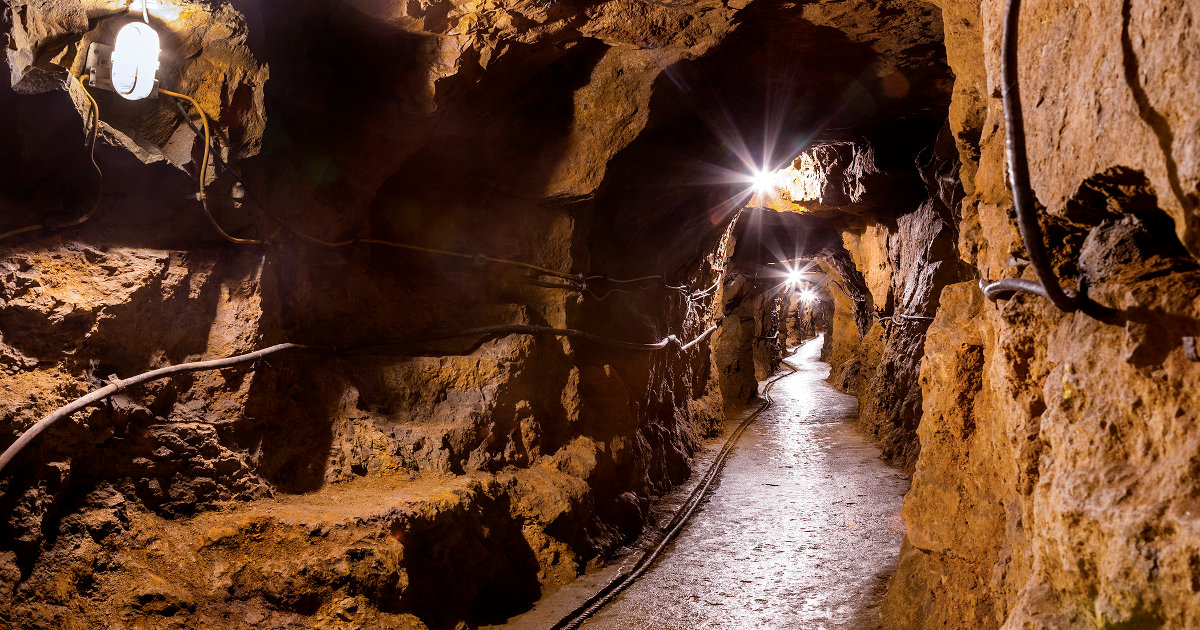
This World Heritage Site is about 20kms NE of Gilwice. There is a bewildering number of prices depending on season and if tour is in Polish or a foreign language. The next tour in English was two hours away, so I took a Polish tour with a written English guide. PLN 34 reduced.
THE CHURCHES of PEACE in Jawor and Świdnica in Silesia were named after the Peace of Westphalia of 1648. It permitted the Lutherans of Silesia to build three churches from wood, loam and straw outside the city walls, without steeples and church bells. The construction time was limited to one year. The third Peace church, erected in Głogów, burned down in 1758. Since 2001, the two remaining churches are listed as UNESCO World Heritage Sites.
Despite the physical and political constraints, three of the churches became the biggest timber-framed religious buildings in Europe due to pioneering constructional and architectural solutions.
The church in Jawor, dedicated to the Holy Ghost is 43.5-metre (143 ft) long, 14-metre (46 ft) wide and 15.7-metre (52 ft) high and has capacity of 5,500. It was constructed by architect Albrecht von Saebisch (1610–1688) from Wroclaw (then German Breslau) and was finished a year later in 1655. The 200 paintings inside by were done by Georg Flegel in 1671–1681. The altar, by Martin Schneider, dates to 1672, the original organ of J. Hoferichter from Legnica of 1664 was replaced in 1855–1856 by Adolf Alexander Lummert.
By that time, the town had been part of the majority Protestant Kingdom of Prussia for about a century. Another 100 years later, in 1945, the town became part of Poland, as a result of the Potsdam Agreement. Although most of the Protestant churches in the German provinces taken over by Poland in 1945 have became Catholic, the two Peace Churches still serve their Lutheran parishes.
The similar church in Świdnica, dedicated to the Holy Trinity, survived like the one in Jawor. Both were restored by a Polish–German cooperation.
Church of Peace in Świdnica. Permission to build this church was given by the Austrian emperor with the conditions that it must be built using impermanent materials (ie no stone or brick) and that it must be completely constructed in one year. As a result this church was built in one year from 1656-57 using 7000 oak trees. It is 1,090m2 and can hold 7,500 with seating for 3000. I saw the church in Swidnica both outside and in. It is an Evangelical Lutheran church, the largest wooden evangelical church (by capacity – 7,500) in Europe.
The outside looks Tudor in design with half-timbered construction – black timbers and white plaster. Built as a square cross, the inside is overwhelming. It has 2 balconies faced with bible sayings and small paintings all in gilt frames and ceilings with an orange floral motif. The altar, pulpit and organ are covered with white marble statues all adorned with gilt. The many small paintings and crests have elaborate gilt frames. The main ceiling is covered with angels surrounding 3 large paintings. The small high windows are clear glass and light is provided by chandeliers and wall sconces.
It was declared, along with the Church of Peace in Jawor, a World Heritage Site in 2001.
A monologue in either German or Polish plays constantly explaining the church. Free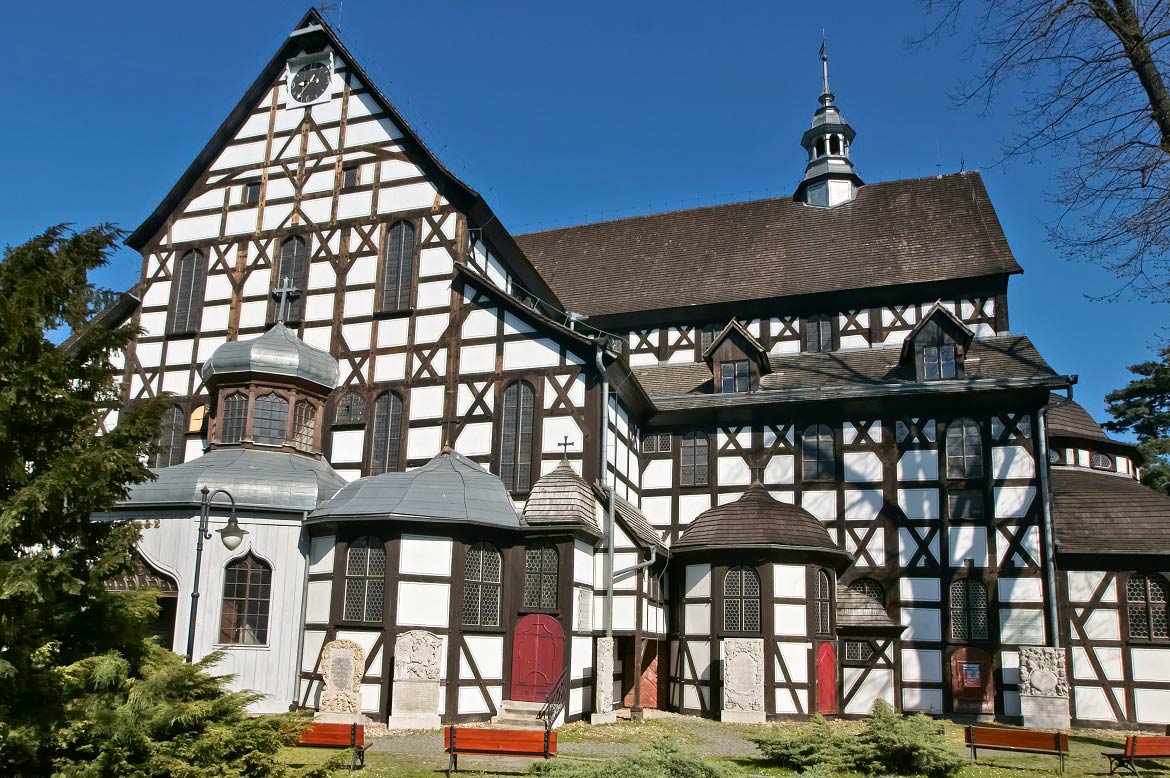
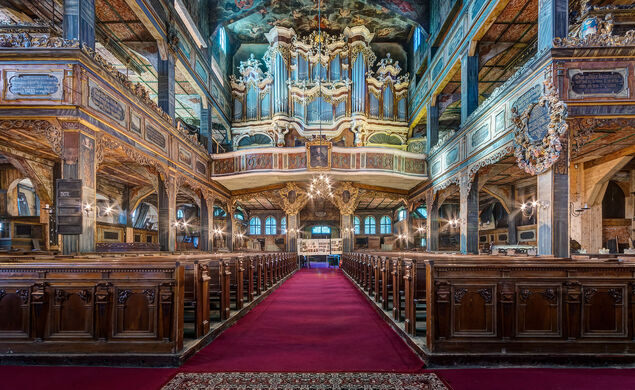

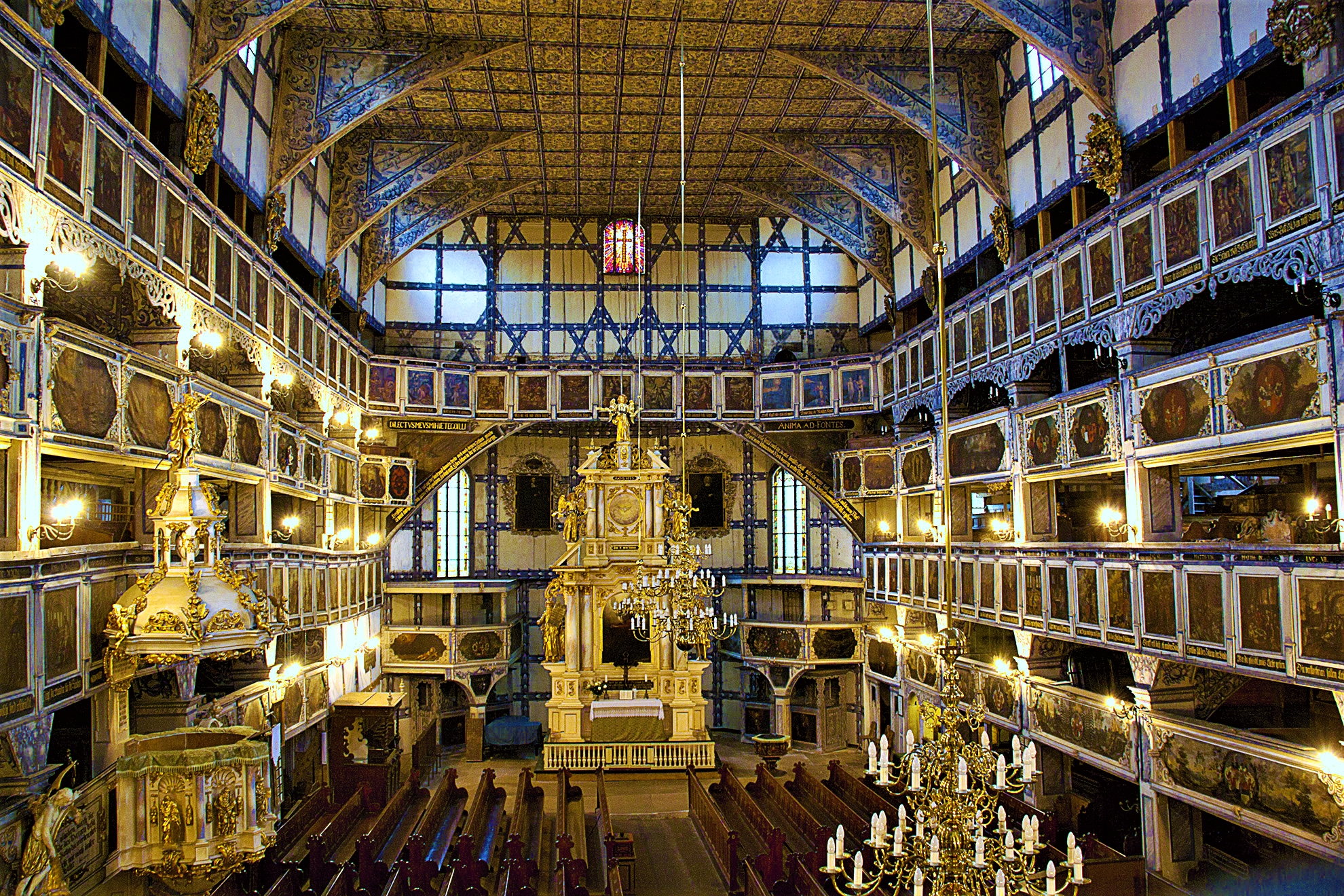 Church of Peace in Jawor. I then decided to see its sister church, about 35kms to the northwest. Unfortunately it was closed but the outside looks almost identical – half-timbered with white plaster – except the wood is stained brown instead of black.
Church of Peace in Jawor. I then decided to see its sister church, about 35kms to the northwest. Unfortunately it was closed but the outside looks almost identical – half-timbered with white plaster – except the wood is stained brown instead of black.
Legnica. (pop 100,000)
In the central part of Lower Silesia, on the Kaczawa River (left tributary of the Oder) and the Czarna Woda.
The city was first mentioned in 1004. It became the residence of the High Dukes that ruled the Duchy of Legnica from 1248 until 1675. Legnica is a city over which the Piast dynasty reigned the longest, for about 700 years, from the time of ruler Mieszko I of Poland after the creation of the Polish state in the 10th century until 1675 and the death of the last Piast duke George William.
Legnica became renowned for the fierce battle in 1241 during the Mongol invasion of Europe. The Christian coalition under the command of the Polish Duke Henry II the Pious, supported by nobles, knights, and mercenaries, was decisively defeated by the Mongols. This, however, was a turning point in the war as the Mongols, having killed Henry II, halted their advance into Europe and retreated to Hungary through Moravia.
During the High Middle Ages, Legnica was one of the most important cities of Central Europe, having a population of nearly 16,000 inhabitants. The city began to rapidly develop after the sudden discovery of gold in the Kaczawa River between Legnica and the town of Złotoryja. In 1675 it was incorporated into Habsburg ruled Kingdom of Bohemia. In 1742 the city was annexed by the Kingdom of Prussia after King Frederick the Great’s victory over Austria in the War of the Austrian Succession. It remained, as a city with a German majority, a part of Germany until the end of World War II, when all Silesia east of the Neisse (Nysa), was transferred to Poland following the Potsdam Conference in 1945 following demands by the Polish delegation that Poland be compensated for the loss of the Kresy.
Legnica is an economic, cultural and academic centre in Lower Silesia, together with Wrocław. The city is renowned for its varied architecture, spanning from early medieval to modern period, and its preserved Old Town with the Piast Castle.
Lubiąż Abbey, Lubiąż. A former Cistercian monastery, it is about 54 km northwest of Wrocław. The abbey, established in 1175, is one of the largest Christian architectural complexes in the world and is considered a masterpiece of Baroque Silesian architecture. Built over centuries, the abbey – the biggest Cistercian abbey in the world has a roof area of about 25,000 square metres. The façade, with a length of 223 m (732 ft), is the longest in Europe after that of El Escorial in Spain. In the crypts are 98 well preserved mummies of Silesian dukes.
In 1327 the Silesian duke Henry VI the Good declared himself a vassal of King John of Bohemia, and when he died without male heirs in 1335, his lands including Leubus fell to the Kingdom of Bohemia. The monastery complex was devastated by the Hussite Wars, and furthermore the monks were expelled by warlike Duke Jan II the Mad in 1492, who turned the abbey into a hunting lodge. The Cistercians were not able to return until Jan II retired. In the 16th century the abbey had to deal with the Protestant Reformation and the inheritance of the Lands of the Bohemian Crown by the Austrian House of Habsburg.
In the 17th and 18th centuries, the monastery was converted into baroque palace with some grand rooms – Ducal Hall (1735 with 10 panel paintings of the Piast and Hapsbergs plus impressive sculptures), Refectory (panoramic fresco) and Dining Room (also frescoed).
The Cistercians were expelled from Lubiąż in 1810 by King Frederick William III of Prussia. During World War II, the buildings of the former abbey were used for secret research laboratories and manufacturing facilities, among other things for the development of radar components (by Telefunken), and then saw production of engines for V1 and V2 rockets (using prisoners for labour). At the end of the war, the former abbey housed soldiers of the Red Army, and then a Russian military psychiatric hospital, with significant damage (e.g., wooden furnishings were burned in stoves). Decades of neglect followed.
Since 1989, the abbey has been under renovation and has become a significant tourist destination. Each year in early June, a Festival of alternative culture, called SLOT Art, takes place here.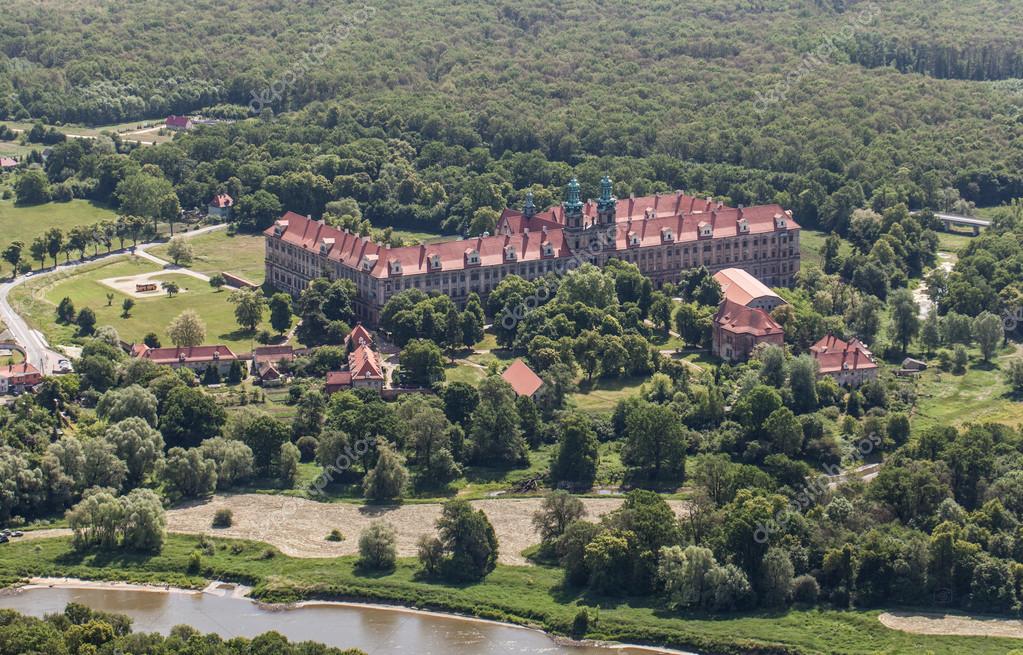

WROCLAW World Cities and Popular Towns
St. Elizabeth’s Church. This 3-naved church has white walls with red brick ribs, arches and columns. The central nave is narrow and high, backed by a beige marble altar and fine stained glass. The ribs over the apse are multi-coloured with remnants of frescoes. Some of the side chapels may be the highlight with inlaid wood and ornate bilt frames. Free
Market Hall (Hala Targowa). Housed in an old brick building with a clock tower, this atmospheric market smelt great. It is relatively small with a wide selection of everything (more flowers than anything else) plus some great small eateries. 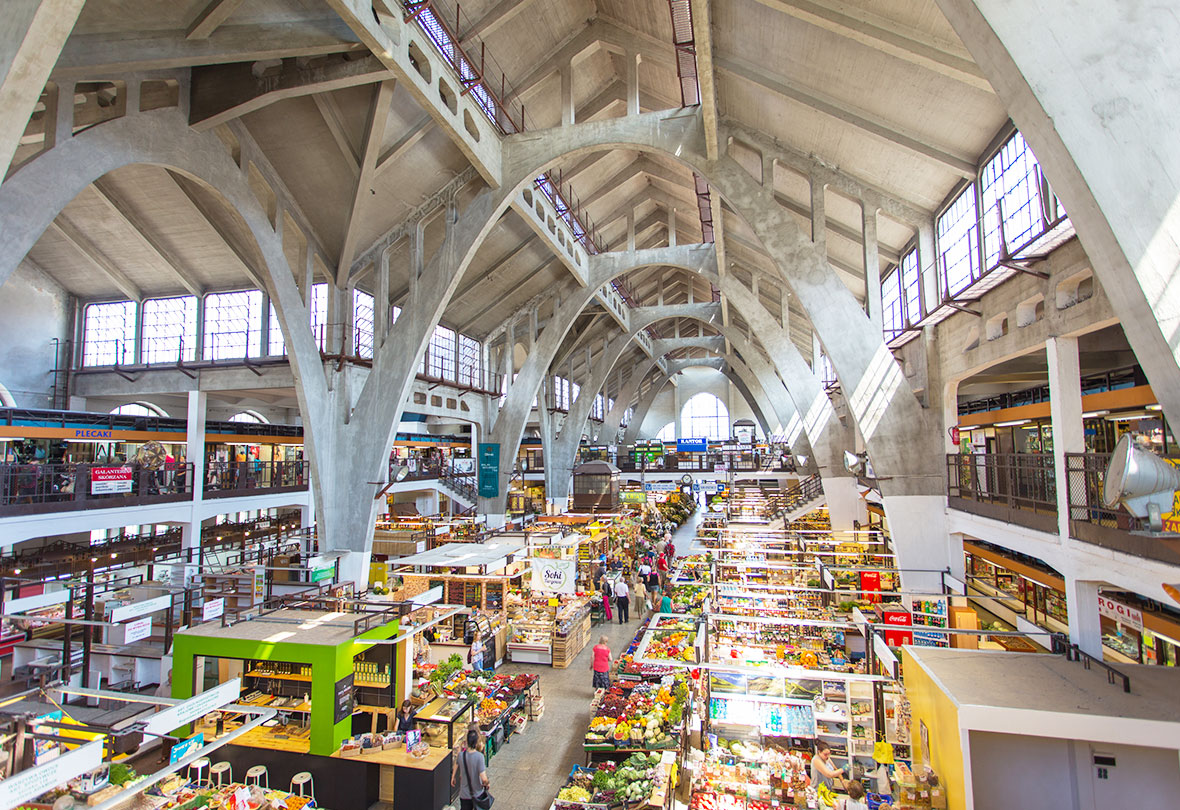
Cathedral of St. John the Baptist. Dim and dark inside because the only windows are high and dark stained glass. The 3 naves have brick walls and grey stone arches. It is known for the altar of Bishop Andreas Jerin (b. 1585-96). The centre is a silver Crucifixtion surrounded by 4 wings of saint patrons of the church. When the wings are closed the 8 paintings have scenes of St John the Baptist. It was plundered in 1632 and again in 1945, but the altar had been preserved elsewhere. Since 2017, it has been in the National Museum in Wroclaw.
Wroclaw University Botanical Garden. This garden has few distinguishing features except possibly the ivy covering all the brick buildings that surround it. PLN 15, 10 reduced
Centennial Hall in Wrocław. Built in 1905 of reinforced concrete to commemorate the 100th anniversary of the Battle of Leipzig when Napoleon was defeated. The city was then part of the German Empire. It was designed to serve as a multifunctional structure to host exhibitions, concerts, theatrical and opera performances, and sporting events. The hall continues to be used for sporting events and concerts.
The cupola modeled on the Festhalle Frankfurt was made of reinforced concrete, and with an inner diameter of 69 m (226 ft) and 42 m (138 ft) high it was the largest building of its kind at the time of construction. The symmetrical quatrefoil shape with a large circular central space seated 7,000 persons. The dome itself is 23 m (75 ft) high, made of steel and glass. The Jahrhunderthalle became a key reference for the development of reinforced concrete structures in the 20th century.
At the centre of the structure a superior dome with lantern is situated. Looking from the inside, there is a clearly visible pattern of the Iron Cross at the top of the dome; for this reason the centre of the structure was shrouded during the Communist era in Poland.
The grounds include a huge pond with fountains enclosed by a huge concrete pergola in the form of half an ellipse. Beyond this, to the north, a Japanese garden was created.
It was also listed as a UNESCO World Heritage Site in 2006.
After the war, when the city (together with most of historical Silesia) had become part of the Republic of Poland according to the 1945 Potsdam Agreement, the hall was renamed Hala Ludowa (“People’s Hall”) by the communist authorities. In 1948, a 106 m (348 ft) high needle-like metal sculpture called Iglica was set up in front of it. The hall was extensively renovated in 1997, in 2010 and again in 2019.
Following the renovation in 2009–11, the arena can now hold 10,000 people.
The hall was originally provided with a Sauer pipe organ built by Walcker Orgelbau, which then, with 15,133 pipes and 200 stops, ranked as the world’s largest. Most parts of the organ were transferred to the rebuilt Wrocław Cathedral after World War II.
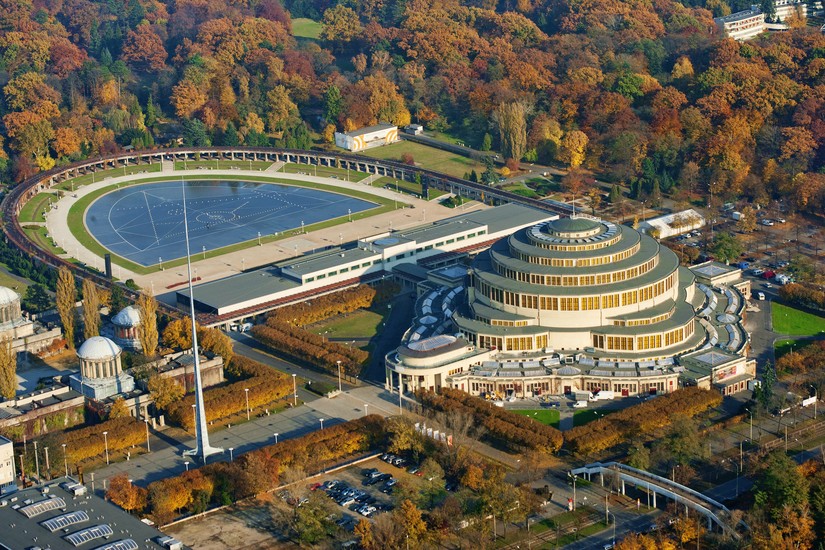
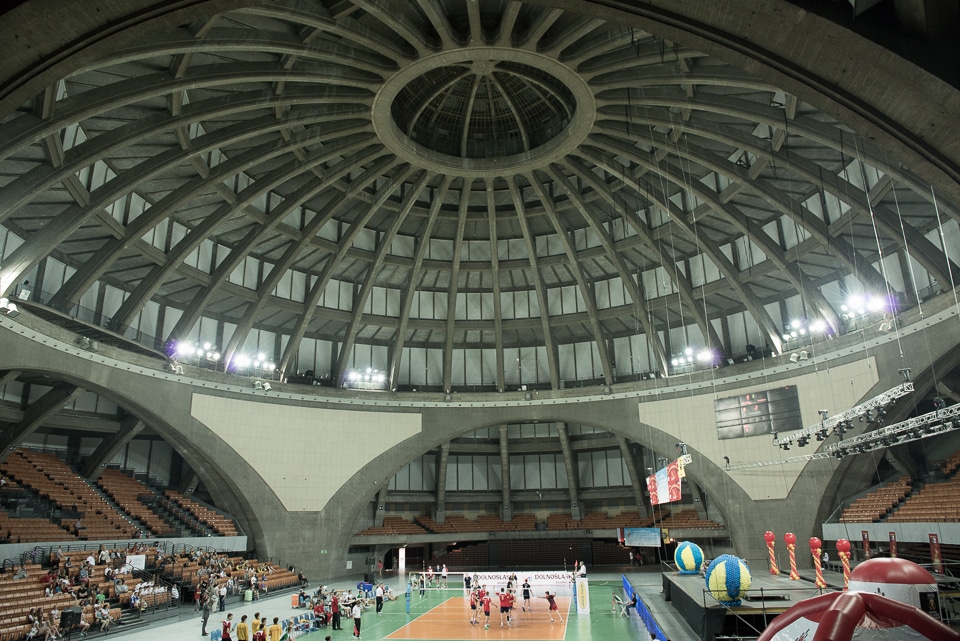
Sky Tower. Sky Tower is the tallest building in Poland in the category of height to roof and category of highest floor, and the second tallest structure overall after the Palace of Culture and Science in Warsaw. A publicly accessible viewpoint is located on the 49th floor of the completely round building.
According to the initial architectural plans, Sky Tower would be a residential, office and commercial complex consisting of 7 buildings of various heights. Like many construction sites around the world, Sky Tower was affected by the 2008 economic crisis, and construction of the tower ceased for a full year. In 2009 it was redesigned with a lower overall height of 212 meters. 2012 saw the opening of a shopping center in the Sky Tower complex.

Park Handlowy Bielany. 12kms south of the city, this shopping mall has the usual.
Sanctuary of St. Jadwiga, Trzebnica. This 3-nave baroque church has over the top decoration – the altar, altars in the side chapels, the large of sarcophagus under a black marble canopy, large statues on top of marble stands, paintings in gilt frames of St Jadwiga on all the columns, carved wood confessionals,
and elaborate side altars adorning every column – marble, gilt, statues each surrounding a painting and round medallion. Art hangs everywhere, including the Ways of the Cross. Free
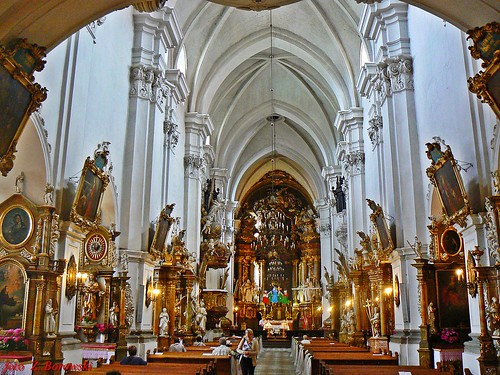
It is about 25kms north of Wroclaw.
NOMAD MANIA Poland – Silesia, Lower Silesia, Opole (Katowice, Wrocław, Częstochowa)
World Heritage Sites
Centennial Hall in Wrocław
Churches of Peace in Jawor and Świdnica
Tarnowskie Gory Lead-Silver-Zinc Mine and its Underground Water Management System
Sights
Jaskinia Niedzwiedzia (Bear Cave), Kletno
Borders
Czechia-Poland
Germany-Poland
Poland-Slovakia
XL
Bogatynia border area (Jelenia Gora)
Cieszyn/Český Těšín
Görlitz/Zgorzelec
Walbrzych south (Klodzko area)
Museums
Gliwice: Museum in Gliwice – Gliwice Radio Station + the Piast Castle
Mysłowice: Central Museum of Firefighting
xRadzionkow: Museum of Bread, School and Curiosities
Castles, Palaces, Forts
Czocha: Czocha Castle
Podzamcze: Ogrodzieniec Castle
Pszczyna: Pless Castle
Sosnowiec: Schoen Palace Museum in Sosnowiecnew
Srebrna Góra: Fort Srebrna Góra
Religious Temples
Jawor: Jawor Peace Church (WHS)
Krzeszów: Krzeszów Abbey
Lubiąż: Lubiąż Abbey
Świdnica: Świdnica Peace Church (WHS)
xŚwięta Góra: Święta Góra Basilica
Trzebnica: Sanctuary of St. Jadwiga
Wambierzyce: Basilica of the Visitation
World of Nature: Stołowe Mountains
Festivals
Avant Art, Wroclaw
Juwenalia
OFF Festival, Katowice
Tauron Nowa Muzyka, Katowice
Botanical Gardens
Goczalkowice-Zdroj: Ogrody Kapias (permanently closed)
Mikołów: Silesian Botanical Garden
Zabrze Botanical Garden
Waterfalls: Kamienczyk Waterfall
Caves: Jaskinia Niedźwiedzia (Bear Cave)
Ski Resorts
Karpacz
Szczyrk
Szklarska Poręba
Monuments: Słubice: Wikipedia Monument
Pedestrian Bridges: Görlitz/Zgorzelec: Altstadtbrücke
Railway Museums: Jaworzyna Śląska: Railway Museum (Muzeuem Kolejnictwa a Slasku)
Vehicle Museums: Sleza: Topacz Auto Museum
The Dark Side
Kudowa Zdroj: Kaplica Czaszek ossuary (Skull Chapel)
Oświęcim: Auschwitz-Birkenau Memorial and Museum
CHORZOW
Botanical Gardens: Rosarium
Planetariums: Silesian Planetarium
Theme Parks: Silesian Amusement Park (Legendia Slaskie Wesole Miasteczko)
Open-Air Museums: Upper Silesian Ethnographic Park
KARPACZ
Museums
Muzeum Sportu i Turystyki
Private Museum of Video Games
European Cities
LEGNICA
RYBNIK
GLOGOW
JASTRZEPIE-ZDROJ
BIELSKO BIALA
Museums: Bielsko-Biała: Museum of Technology and Textile Industry (Stara Fabryka)
Castles, Palaces, Forts: Bielsko-Biala Museum and Castle
JELENIA GORA
House Museums/Plantations: Municipal Museum of Gerhart Hauptmann’s House
CZESTOCHOVA
Castles, Palaces, Forts: Moszna Castle: The Black Madonna of Czestochowa
Railway, Metro, Funiculars, Cable Cars: Częstochowa Trams
Museums
Czestochowa Museum (Museum XX. Czartoryskich w Krakowie)
Museum of the Production of Matches
Religious Temples: Jasna Gora Monastery (Black Madonna of Częstochowa)
KATOWICE and SILESIAN METROPOLIS World Cities and Popular Towns
Airports: Katowice (KTW)
Railway, Metro, Funiculars, Cable Cars: Silesian Interurbans (trams)
Museums
Computer Museum
Katowice History Museum
Silesian Museum
Monuments: Silesian Insurgents Monument
Bizzarium: Spodek
OPOLE
Museums: Museum of Opole Silesia
Zoos: Opole Zoo
WALBRZYCH
Museums: Porcelain Museum in Wałbrzych
Castles, Palaces, Forts: Książ Castle
WROCLAW World Cities and Popular Towns
World Heritage Sites: Centennial Hall in Wrocław
Sights: Wroclaw Old town
Airport: Wroclaw (WRO)
Railway, Metro, Funiculars, Cable Cars: Wroclaw Trams
Museums
Museum of Architecture
Museum of Medallic Art
National Museum
Castles, Palaces, Forts: Royal Palace (City Museum of Wroclaw)
Religious Temples
Cathedral of St. John the Baptist
St. Elizabeth’s Church
Modern Architecture Buildings
Centennial Hall
Sky Tower
Entertainment/Things to do: Hydropolis
Zoos: Wrocław Zoo
Botanical Gardens: Wroclaw University Botanical Garden
Malls/Department Stores: Park Handlowy Bielany
Markets: Market Hall (Hala Targowa)
Villages and Small Towns
Bolesławiec
Byczyna
Lądek-Zdrój
Nysa
Polanica-Zdrój
Złotoryja
KLODZKO
Castles, Palaces, Forts: Kłodzko: Kłodzko Fortress
SWIDNICA
World Heritage Sites: Churches of Peace in Jawor and Świdnica
